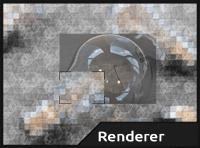 LuxRender is a physically based and unbiased rendering engine. Based on state of the art algorithms, LuxRender simulates the flow of light according to physical equations, thus producing realistic images of photographic quality. LuxRender you can use like a standalone software and also as a scene export plugin for 3D modeling software, e.g. 3ds Max, Cinema 4D, Blender, Softimage and others. The current version is still officially a release candidate, but according to a posting on the LuxRender forum, “we decided to jump the version number to 1.0 to emphasize the fact that LuxRender is a production-ready application, as is constantly demonstrated by the various artists using it”.
LuxRender is a physically based and unbiased rendering engine. Based on state of the art algorithms, LuxRender simulates the flow of light according to physical equations, thus producing realistic images of photographic quality. LuxRender you can use like a standalone software and also as a scene export plugin for 3D modeling software, e.g. 3ds Max, Cinema 4D, Blender, Softimage and others. The current version is still officially a release candidate, but according to a posting on the LuxRender forum, “we decided to jump the version number to 1.0 to emphasize the fact that LuxRender is a production-ready application, as is constantly demonstrated by the various artists using it”.
What brings new version:
Normal Maping - Normal maps in LuxRender can be applied to any material, and (if desired), multiple normal and bump maps can be stacked arbitrarily on the same material using the multimix texture.
Improved GPU Acceleration - LuxRender 1.0 builds on the GPU-accelerated "hybrid sampler" renderer introduced in v0.8. Hybrid offloads ray-intersection calculations to the graphics card using OpenCL
Updated Materials – this version includes a new metal material, metal 2. Metal 2 supports custom colors and textures, as well as measured data from Sopra and Luxpop Nk files and arbitrary IORs and new layered material allows other materials to be combined in a realistic stack.
Multi-step Motion Blur - supports multiple steps over an arbitrary amount of time, rather than a single transform relative to the frame time. This allows more precise control of blur amount as well as curved trails for object and camera transform blur.
Core Improvements - LuxRender 1.0 features numerous updates, including a multithreaded film buffer, more robust networking, a new acceleration structure, an updated light sampling system, and numerous bug fixes.
GUI Improvements - Many of the icons have been replaced for a more consistent and descriptive icon set.
SPPM- Stochastic Progressive Photon Mapping integrator builds a map of the "view" of the camera, fires photons to light this shot, and then repeats this process again with a new rendering of the view and a smaller photon radius. This allows for a theoretically infinite number of photons with a search radius that trends towards zero.
Source: LuxRender
